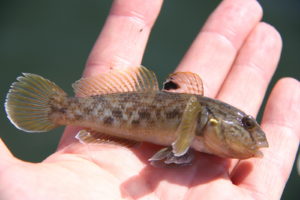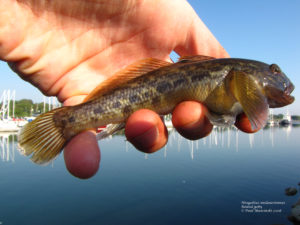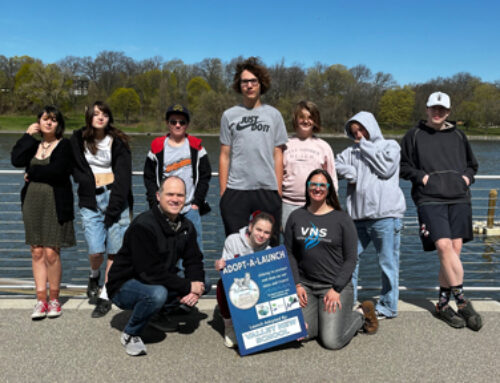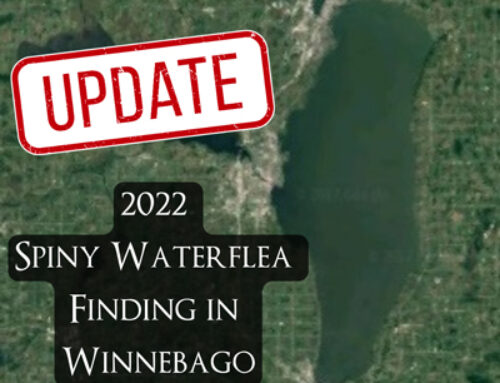Little Fish, Big Changes
Round gobies (Neogobius melanostomus) are native to the Black and Caspian Sea regions in Europe/Asia. They were introduced into the Great Lakes through ballast water from trans-continental ships and were first discovered in 1990 in the St. Clair River and have quickly spread. Round gobies are found in all of the Great Lakes, attached tributaries up to the first impassable dam, and some inland waters in the United States. However, round gobies are currently in only one inland lake in Wisconsin; Little Lake Butte des Morts.

Photo Credit: Paul Skawinski
The initial report of a round goby being caught by an angler in Little Lake Butte des Morts in August 2015 triggered a large scale sampling response that confirmed the presence of a round goby population in the lake. After consulting with the DNR, the Fox River Navigational System Authority (FRNSA) made the decision to close the Menasha lock in order to help prevent the spread of the round gobies into the Winnebago System. FRNSA is also working to create a realistic plan to resume operation of the Menasha lock to allow passage of boats between Little Lake Butte des Morts and Lake Winnebago while still protecting Winnebago from invasion by the gobies. Several plans have been suggested and are under further consideration. More information can be found on their website.
Round gobies have a black spot on the first dorsal fin and a fused pelvic fin that resembles a suction cup (no native fish in the Great Lakes has a fused pelvic fin). Juvenile gobies are a solid slate gray. Gobies are usually 2.5-6 in. long, but a few have been found up to 9.75 in. long. The fused pelvic fin is one of the easiest ways to identify a round goby and differentiate it from similar-looking native species including the mottled sculpin and log perch.

Photo Credit: Paul Skawinski
Round gobies can have an enormous impact on the ecosystem. Once they invade, round gobies can quickly take over native rocky habitat since they reproduce over six times per year. Gobies also feed on fish eggs. Both the high reproductive rate and decline in fish eggs can cause a decline in native species. Zebra mussels are a major component of the round gobies’ diet in their native range of central Eurasia with some reports finding that a single goby can eat 78 zebra mussels per day. However, the use of biocontrol techniques (using one species to reduce/eradicate another species) can often times result in unintended consequences, and it is generally not a good idea to use this technique. Also, there are often both positive and negative impacts associated with invasive species. While gobies would most likely eat zebra mussels, it is not known if their impact would result in a large decline in zebra mussels or if a decline would even be detectable (a mature female zebra mussel may release up to one million eggs per year). In the Great Lakes, round gobies can potentially spread deadly botulism through the food chain, which is acquired when gobies eat infected zebra mussels and then ducks eat the gobies. The gobies will also aggressively defend their spawning habitat that native fish also need to reproduce. As a result, a lot of small native fish may not be able to find a place to reproduce if gobies were to establish in large numbers. Shoreline fishing may also be negatively impacted by round gobies. Anglers in Chicago and Milwaukee are catching mostly round gobies from shore as this fish reproduces quickly, is very aggressive, and attacks lures.
However, there are instances of non-negative round goby impacts. In Lake Erie, gobies have come to comprise the majority of the diet of water snake. As a  result of the abundance of round gobies, the population size and growth rate of water snakes increased leading to the removal of the snake from the federal Endangered Species list in 2011. An increase in several sportfish populations in several goby-invaded systems have also been highly credited to round gobies such as walleye, yellow perch, and smallmouth bass. However, these increases may be due to the high abundance of gobies following a goby-caused decline in similarly sized native fish species.
result of the abundance of round gobies, the population size and growth rate of water snakes increased leading to the removal of the snake from the federal Endangered Species list in 2011. An increase in several sportfish populations in several goby-invaded systems have also been highly credited to round gobies such as walleye, yellow perch, and smallmouth bass. However, these increases may be due to the high abundance of gobies following a goby-caused decline in similarly sized native fish species.
Larger fish have been known to eat gobies and this invasive species can become another potential source of food for game fish. The addition of round gobies into the food web may be beneficial to certain species, while detrimental to others. Each species has a niche, or “way of life” which is defined by the environmental conditions, resources, and interactions it needs to survive at various stages of its life. The goby, like most other invasive species, is very efficient at displacing native species from their respective niches. As a result, invaded lakes experience simpler food webs with fewer animal/plant species. With fewer species, the system is more vulnerable to collapsing if something happens to part of the food web. Everything is interconnected like a spider web; if one strand of the web is cut, the entire web is affected.
The Winnebago ecosystem is unique, and while it is true that it contains many of the same fish species that are present in other waters with established gobies, it doesn’t mean that the ecosystem will experience the same results as other established goby waters if the round goby gets into Lake Winnebago. With the goby situation in the Winnebago Waterways system, one thing can be said with absolute certainty; if the introduction of gobies can be prevented to begin with, the risk will not need to be taken on the potential negative effects on the ecosystem if they do become established.
Want to help? HELP PREVENT THE SPREAD!
Every time you come off the water, make sure to follow these steps to stop the spread of faucet snails and other aquatic invasive species:
* Inspect boats, trailers, push poles, anchors, and other equipment for attached aquatic plants or animals.
* Remove all attached plants or animals
* Drain all water from boats, motors, livewells and other equipment
* Never move live fish away from a waterbody
* Never release aquarium plants or animals into your local waterways
Follow the Fox Wolf Watershed Alliance’s Winnebago Waterways Program on our Winnebago Waterways Facebook page or @WinnWaterways on Twitter! You can also sign-up for email updates at WinnebagoWaterways.org.
This article was written by Chris Acy, the AIS Coordinator for the Winnebago Waterways Program covering Fond du Lac, Calumet, and Winnebago Counties.
Questions? Comments? Contact Chris Acy, our Aquatic Invasive Species Coordinator at (920) 460-3674 or chris@fwwa.org!
Winnebago Waterways is a Fox-Wolf Watershed Alliance program. The Fox-Wolf Watershed Alliance is an independent nonprofit organization that identifies and advocates effective policies and actions that protect, restore, and sustain water resources in the Fox-Wolf River Basin.






Good Morning ! I am sorry that I don’t have the time right now to get organized and do a scratch copy, so I could do this more intelligently . . . but. . . I would like the, Historic 150 years plus, Fox River and it’s 17 locks and canals , that run through many cities –
from Menasha to Green Bay to be enjoyed by citizens (who pay their taxes to the state) to enjoy their river for each and every wau they desire. The boating fisherman have dominated the river since the river closed in 1988 to keep out invasive species which is never going to end. They are here, will continue to come, (the FDl ducks fly to Sheboygan every day and they transport eggs back and forth – along with the fisherman who transport their boats from the many harbors in the state. If you have to electrify the locks at Menasha and Rapide Croche , please move quicker. My family has been involved since this all started in 1982 when I was 49 and I am now 85 – we ran the river , with power and sailboat every year starting in 1949 and I want to be alive when it opens again. I understand what John Forester went through- all the years when he worked so hard, but now, after losing generations of interest, I hope the Authority can step up the progress and open the river, so the cities can benefit from this “Gold Mine” waiting to be tapped. The Friends of the Fox can help but we need to help the Authority to accomplish the goal Good Luck!
Wish I had a copy of this – did pretty good considering who I am and am never organized – – do good!!!!!!!!!!!!!
Thank you for sending us your thoughts on the issue! We always enjoy hearing from people who are passionate about the system.